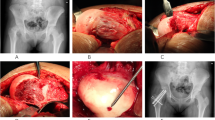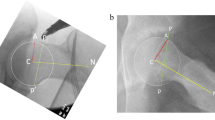Abstract
Background
Traditionally arthrotomy has rarely been performed during surgery for slipped capital femoral epiphysis (SCFE). As a result, most pathophysiological information about the articular surfaces was derived clinically and radiographically. Novel insights regarding deformity-induced damage and epiphyseal perfusion became available with surgical hip dislocation.
Questions/purposes
We (1) determined the influence of chronicity of prodromal symptoms and severity of SCFE deformity on severity of cartilage damage. (2) In surgically confirmed disconnected epiphyses, we determined the influence of injury and time to surgery on epiphyseal perfusion; and (3) the frequency of new bone at the posterior neck potentially reducing perfusion during epimetaphyseal reduction.
Methods
We reviewed 116 patients with 119 SCFE and available records treated between 1996 and 2011. Acetabular cartilage damage was graded as +/++/+++ in 109 of the 119 hips. Epiphyseal perfusion was determined with laser-Doppler flowmetry at capsulotomy and after reduction. Information about bone at the posterior neck was retrieved from operative reports.
Results
Ninety-seven of 109 hips (89%) had documented cartilage damage; severity was not associated with higher slip angle or chronicity; disconnected epiphyses had less damage. Temporary or definitive cessation of perfusion in disconnected epiphyses increased with time to surgery; posterior bone resection improved the perfusion. In one necrosis, the retinaculum was ruptured; two were in the group with the longest time interval. Posterior bone formation is frequent in disconnected epiphyses, even without prodromal periods.
Conclusions
Addressing the cause of cartilage damage (cam impingement) should become an integral part of SCFE surgery. Early surgery for disconnected epiphyses appears to reduce the risk of necrosis. Slip reduction without resection of posterior bone apposition may jeopardize epiphyseal perfusion.
Level of Evidence
Level IV, retrospective case series. See Guidelines for Authors for a complete description of levels of evidence.


Similar content being viewed by others
References
Aronsson DD, Loder RT. Treatment of the unstable (acute) slipped capital femoral epiphysis. Clin Orthop Relat Res. 1996;322:99–110.
Aronsson DD, Loder RT, Breur GJ, Weinstein SL. Slipped capital femoral epiphysis: current concepts. J Am Acad Orthop Surg. 2006;14:666–679.
Ballard J, Cossgrove AP. Anterior physeal separation: a sign indicating a high risk for avascular necrosis after slipped capital femoral epiphysis. J Bone Joint Surg Br. 2002;84:1176–1179.
Carney BT, Weinstein SL, Noble J. Long-term follow-up of slipped capital femoral epiphysis. J Bone Joint Surg Am. 1991;73:667–674.
Casey BH, Hamilton HW, Bobechko WP. Reduction of acutely slipped upper femoral epiphysis. J Bone Joint Surg Br. 1972;54:607–614.
Dodds MK, McCormack D, Mulhall KJ. Femoroacetabular impingement after slipped capital femoral epiphysis: does slip severity predict clinical symptoms? J Pediatr Orthop. 2009;29:535–539.
Dunn DM. Replacement of the femoral head by open operation in severe adolescent slipping of the upper femoral epiphysis. J Bone Joint Surg Br. 1978;60:394–403.
Ganz R, Gill TJ, Gautier E, Ganz K, Krügel N, Berlemann U. Surgical dislocation of the adult hip: a technique with full access to the femoral head and acetabulum without the risk of avascular necrosis. J Bone Joint Surg Br. 2001;83:1119–1124.
Ganz R, Huff TW, Leunig M. Extended retinacular soft tissue flap for intraarticular hip surgery: surgical technique, indications, and results of application. Instr Course Lect. 2009;58:241–255.
Ganz R, Parvizi J, Beck M, Leunig M, Nötzli H, Siebenrock KA. Femoroacetabular impingement: a cause for osteoarthritis of the hip. Clin Orthop Relat Res. 2003;417:112–120.
Gill TJ, Sledge JB, Ekkernkamp A, Ganz R. Intraoperative assessment of femoral head vascularity after femoral neck fracture. J Orthop Trauma. 1998;12:474–478.
Gordon JE, Abrahams MS, Dobbs MB, Luhmann SJ, Schonecker PL. Early reduction, arthrotomy and cannulated screw fixation in unstable slipped capital femoral epiphysis treatment. J Pediatr Orthop. 2002;22:352–358.
Herman MJ, Dormans JP, Davidson RS, Drummond DS, Gregg JR. Screw fixation of grade III slipped capital femoral epiphysis. Clin Orthop Relat Res. 1996;322:77–85.
Kalhor M, Horowitz K, Gharehdaghi J, Beck M, Ganz R. Anatomic variations in femoral head circulation. Hip Int. 2012;22:307–312.
Kallio PE, Mah ET, Foster BK, Paterson DC, LeQuesne GW. Slipped capital femoral epiphysis. Incidence and assessment of physeal instability. J Bone Joint Surg Br. 1995;77:752–755.
Larson AN, Sierra RJ, Yu EM, Trousdale RT, Stans AA. Outcomes of slipped capital femoral epiphysis treated with in situ pinning. J Pediatr Orthop. 2012;32:125–130.
Leunig M, Casillas MM, Hamlet M, Hersche O, Nötzli H, Slongo T, Ganz R. Slipped capital femoral epiphysis. Early mechanical damage to the acetabular cartilage by a prominent femoral metaphysis. Acta Orthop Scand. 2000;71:370–375.
Leunig M, Horowitz K, Manner H, Ganz R. In situ pinning with arthroscopic osteoplasty for mild SCFE: a preliminary technical report. Clin Orthop Relat Res. 2010;468:3160–3167.
Leunig M, Slongo T, Ganz R. Subcapital realignment in slipped capital femoral epiphysis: surgical hip dislocation and trimming of the stable trochanter to protect the perfusion of the epiphysis. Instr Course Lect. 2008;57:499–507.
Loder RT. Unstable slipped capital femoral epiphysis. J Pediatr Orthop. 2001;21:694–699.
Loder RT, Aronsson DD, Weinstein SL, Breur GJ, Ganz R, Leunig M. Slipped capital femoral epiphysis. Instr Course Lect. 2008;57:473–498.
Loder RT, Richards BS, Shapiro PS, Reznik LR, Aronsson DD. Acute slipped capital femoral epiphysis: the importance of physeal stability. J Bone Joint Surg Am. 1993;75:1134–1140.
Lubicky JP. Chondrolysis and avascular necrosis: complications of slipped capital femoral epiphysis. J Pediatr Orthop B. 1996;5:162–167.
Marx RG, Stump TJ, Jones EC, Wickiewicz TL, Warren RF. Development and evaluation of an activity rating scale for disorders of the knee. Am J Sports Med. 2001;29:213–218.
Mooney JF III, Sanders JO, Browne RH, Anderson DJ, Jofe M, Feldman D, Raney EM. Management of unstable/acute slipped capital femoral epiphysis: results of a survey of the POSNA membership. J Pediatr Orthop. 2005;25:162–166.
Noetzli HP, Siebenrock KA, Hempfing A, Ramseier LE, Ganz R. Perfusion of the femoral heads during surgical dislocation of the hip: monitoring by laser Doppler flowmetry. J Bone Joint Surg Br. 2002;84:300–304.
Peterson MD, Weiner DS, Green NE, Terry CL. Acute slipped capital femoral epiphysis: the value and safety of urgent manipulative reduction. J Pediatr Orthop. 1997;17:648–654.
Rab GT. The geometry of slipped capital femoral epiphysis: implication for movement, impingement and corrective osteotomy. J Pediatr Orthop. 1999;19:419–424.
Rhoad RC, Davidson RS, Heyman S, Dormans JP, Drummond DS. Pretreatment bone scan in SCFE: a predictor of ischemia and avascular necrosis. J Pediatr Orthop. 1999;19:164–168.
Sankar WN, Partland TG, Millis MB, Kim YJ. The unstable slipped capital femoral epiphysis. Risk factors for osteonecrosis. J Pediatr Orthop. 2010;30:544–548.
Schöniger R, Kain MSH, Ziebarth K, Ganz R. Epiphyseal reperfusion after subcapital realignment of an unstable SCFE. Hip Int. 2010;20:273–279.
Sink EL, Zaltz I, Heare T, Dayton M. Acetabular cartilage and labral damage observed during surgical hip dislocation for stable slipped capital femoral epiphysis. J Pediatr Orthop. 2010;30:26–30.
Slongo T, Kakaty D, Krause F, Ziebarth K. Treatment of slipped capital femoral epiphysis with a modified Dunn procedure. J Bone Joint Surg Am. 2010;92:2898–2908.
Tokmakova KP, Stanton RP, Mason DE. Factors influencing the development of osteonecrosis in patients treated for slipped capital femoral epiphysis. J Bone Joint Surg Am. 2003;85:798–801.
Ziebarth K, Domayer S, Slongo T, Kim YJ, Ganz R. Clinical stability of slipped capital femoral epiphysis does not correlate with intraoperative stability. Clin Orthop Relat Res. 2012;480:2274–2279.
Ziebarth K, Zilkens C, Spencer S, Leunig M, Ganz R, Kim YJ. Capital realignment for moderate and severe SCFE using a modified Dunn procedure. Clin Orthop Relat Res. 2009;467:704–716.
Zilkens C, Jäger M, Bittersohl B, Kim YJ, Millis MB, Krauspe R. [Slipped capital femoral epiphysis] [in German]. Orthopäde. 2010;39:1009–1021.
Acknowledgments
We thank Franco Impellizeri, PhD, from the Research Group at Schulthess Clinic for his statistical support in this study.
Author information
Authors and Affiliations
Corresponding author
Additional information
Each author certifies that he or she, or a member of his or her immediate family, has no funding or commercial associations (eg, consultancies, stock ownership, equity interest, patent/licensing arrangements, etc) that might pose a conflict of interest in connection with the submitted article.
All ICMJE Conflict of Interest Forms for authors and Clinical Orthopaedics and Related Research editors and board members are on file with the publication and can be viewed on request.
Each author certifies that his or her institution approved the human protocol for this investigation, that all investigations were conducted in conformity with ethical principles of research, and that informed consent for participation in the study was obtained.
This work was performed at the Inselspital, Berne, Switzerland; Schulthess Clinic, Zürich, Switzerland; and the Children’s Hospital, Harvard Medical School, Boston, MA, USA.
About this article
Cite this article
Ziebarth, K., Leunig, M., Slongo, T. et al. Slipped Capital Femoral Epiphysis: Relevant Pathophysiological Findings With Open Surgery. Clin Orthop Relat Res 471, 2156–2162 (2013). https://doi.org/10.1007/s11999-013-2818-9
Published:
Issue Date:
DOI: https://doi.org/10.1007/s11999-013-2818-9




